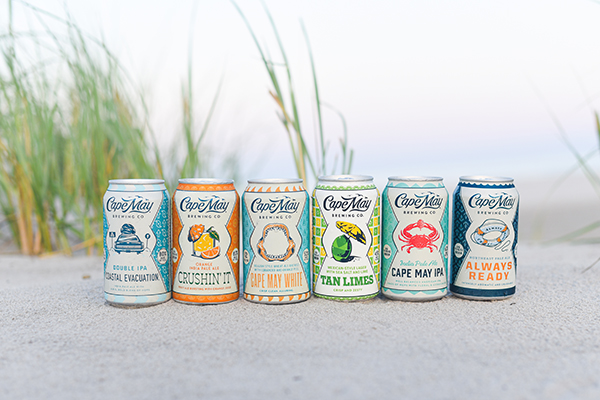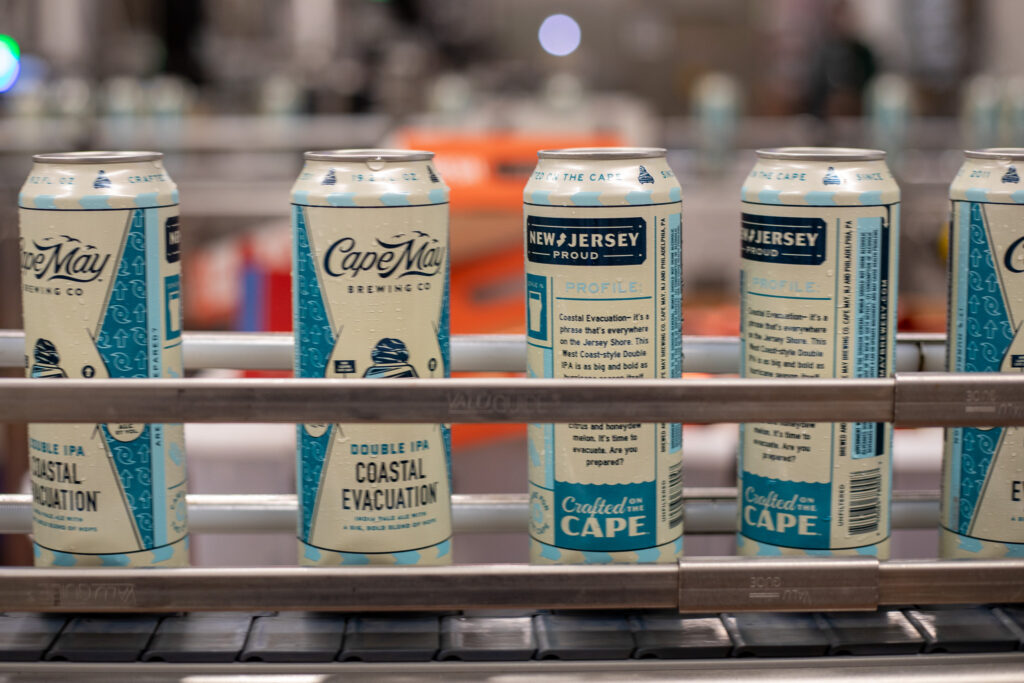A transformative year for the shore’s favorite brewery.
By: Courtney Iseman

Fourteen years is an impressively long tenure in the tumultuous American craft beer market. New Jersey’s Cape May Brewing Co. has not only survived an explosion of breweries across the United States and the subsequent contraction, but they’ve also been able to count themselves among contemporary trailblazers – there were only 1,790 breweries in the country when they opened in 2011, compared to today’s roughly 9,350, and just 28 breweries in New Jersey versus 251 currently. So, it demands attention when a brewery of Cape May Brewing Co.’s status shifts gears to adapt to a changing industry.
In 2025, fans old and new will meet Cape May Brewing Co. 2.0. The brewery will double down on the core brands that made it a favorite and will pepper in seasonal releases, simultaneously exciting longtime devotees and attracting newcomers. This balancing act reflects a bigger one, crucial for success in 2025: A proven track record and reliability, plus the ability to evolve, invent, and engage.
“Focusing on our core brands while strategically introducing innovative seasonal releases makes sense because we’re building a brand that people trust,” says Cape May Co-founder and CEO Ryan Krill. “Our core beers are the foundation – what our fans know and love – so it’s important to maintain that consistency. At the same time, part of what makes this industry exciting is the ability to experiment and surprise our fans. By thoughtfully introducing seasonal releases that are fresh, creative, and limited, we keep things dynamic without overwhelming our lineup.”
Locking in core beers “enables consumers to have high-quality liquid 365 days a year,” says Ethan Peiffer, Origlio Beverage Brand Manager. Meanwhile, well-planned limited releases are valuable opportunities, not just to intrigue those existing fans, but to make new, lasting consumer connections. “People will look forward [to these releases] every year, they’ll talk about them and bring them to gatherings. Their friends will try them, and they’ll get excited, and it creates this ripple effect.”
Cape May’s strategy for 2025 represents a nimbleness that cements the brewery as a key player in today’s market. “The craft beer industry is constantly shifting, and staying ahead means being adaptable and responsive,” Krill says. “Cape May 2.0 embraces the idea that what got us here won’t get us there. As consumer preferences evolve, so do we.” The brewery remains “deeply committed” to long-time, loyal customers, but realizes they must also engage a new audience. To do this, they prioritize listening to their customers, consumers in general, and wholesalers.
The core Cape May lineup waves a banner for the brewery’s unique identity, one that Krill says celebrates the city as America’s first seaside resort. “That same sense of history and charm guides everything we do,” Krill explains. “When crafting our beer program and shaping the atmosphere we create, we focus on three key elements: quality, novelty, and nostalgia. Our goal is to transport [people] to a place that feels both timeless and refreshing – just like Cape May itself.”
What that looks like is beers that even imbibers who have never set foot in Cape May associate with special occasions and everyday quality time with friends, plus reliable, thirst-quenching character. It’s Cape May IPA and Coastal Evacuation Double IPA, Longliner Lager, Devil’s Reach Belgian-Style Ale, and Cape May White Belgian-Style Wheat Ale, among other classic styles done with a Cape May Brewing Co. approach to flavor and quality.

The nostalgia encapsulated by these flagships meets novelty in releases like Cosmic Shores Hazy IPA, which Cape May Marketing Director Alicia Grasso says “caters to IPA lovers with the juicy, tropical notes of Galaxy hops”; Cape May Light, a crisp and refreshing light lager at 4.2% ABV and 99 calories; and an expansion of the brewery’s Orange Crushin’ It 8% ABV IPA series with Mango and Blueberry Lemon.
Cape May flagships, IPA, Coastal Evacuation, and Devil’s Reach, have also launched in 19.2 oz. cans. Krill says this is a “direct response to feedback from our fans, sales team, and retailers. It’s a great way to offer our beers in a format that fits different occasions, whether it’s a single-serve option at an event, a quick grab at a convenience store, or just an easy way to enjoy a favorite brew.”

“This package also provides retailers with more versatility in how they stock and sell SKUs,” Krill adds. Peiffer agrees, explaining, “The 19.2 oz. cans are really showing a lot of growth, and having more than one format really helps brands stand out on a crowded shelf right now.”
To communicate this new-and-improved yet familiar-favorite strategy, Grasso says Cape May Brewing Co. will utilize digital engagement, in-store activations, and direct consumer experiences like tap takeovers, beer dinners, on-premise events, and participating in festivals. They will also position themselves as a destination for Jersey Shore tourists. “We’ll ensure our messaging is that drinking a Cape May brew is ‘what vacation tastes like,’” she says. They’ll speak to long-time fans and new customers alike by reinforcing the presence of core beers along with their tried-and-true nostalgia and commitment to quality, while also emphasizing the new 19.2 oz. format, seasonal releases, and increased retail visibility.
Flagships with which fans have built relationships, seasonal releases worthy of piquing imbiber interest, and a strong plan on Cape May’s part to broadcast both to consumers, all create an appealing partnership for bars, restaurants, and retailers. With their digital engagement and activations, the brewery does the marketing lift for their accounts, leading to valuable customer recognition.
“Cape May gets their name out there with different releases and a concentrated effort on their core beers,” Peiffer says. “It lets people know what they’re getting and makes it simpler for the consumer to make their buying decisions.” “Benefits for both beer drinkers and beer sellers are intentional,” Krill says.
Krill adds, “Cape May 2.0 is about refining how we operate to deliver a better experience for everyone – retailers, bars, and consumers alike. While this is an internal rallying cry, its impact is external. Retailers and bars will benefit from more consistent product, better planning, and stronger execution, meaning fresher beer [and] better availability.”

About the Author: Courtney Iseman is a Brooklyn-based freelance writer covering craft beer and spirits for Food & Wine, Craft Beer & Brewing, Brewing Industry Guide, PUNCH, Inside Hook, VinePair, Thrillist, Wine Enthusiast, and more.
